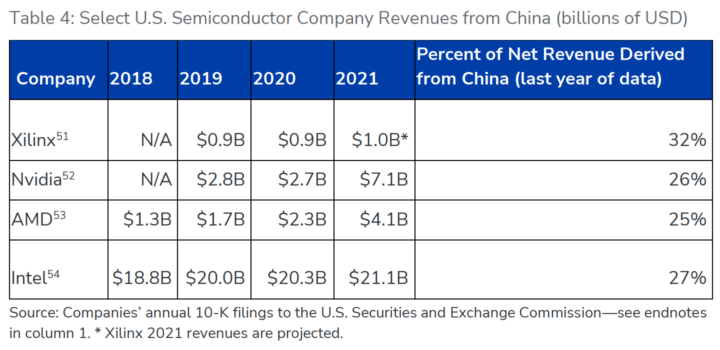Despite measures to limit U.S. technology export to the Chinese military, chips designed by U.S. companies still end up in the hands of the People’s Liberation Army (PLA), according to a report by the Center for Security and Emerging Technology (CSET) at Georgetown University.
CSET combed through over 66,000 publicly available PLA purchase records during the 8-month period from April to November 2020. The researchers identified 97 unique, high-end, Artificial Intelligence (AI) chips the PLA ordered. Nearly all of them were designed by U.S. firms Nvidia, Xilinx (now AMD), Intel, and Microsemi. The CSET report, released in June 2022, also noted that the researchers could not find any public records of PLA purchasing the high-end AI chips from Chinese companies, such as HiSilicon (Huawei), Sugon, Sunway, Hygon, or Phytium.
These AI chips are critical components of the Chinese Communist Party (CCP) for the “intelligentization” (the addition of artificial intelligence to a system according to kaikki.org) of its military, and to dominate the global AI design and manufacturing market.
Even though the CCP has poured tens of billions of dollars into its own semiconductor industry, the report said, Chinese companies, lacking the “intrinsic knowledge and specialized equipment,” still cannot catch up to the U.S. design firms, while South Korea’s Samsung and the Taiwan Semiconductor Manufacturing Company (TSMC) remain the titans of global semiconductor fabrication.
To obtain the U.S. designed AI chips, the CCP has been bypassing the limitations imposed by the recent U.S. export controls.
Dodging Export Control
The Trump administration created, and the Biden administration has maintained, controls designed to curtail technology exports to military end-users in China. These end-user controls, however, do not apply to items made outside the United States. Since most AI chips are made in South Korea and Taiwan, the end-users controls have very little power to limit the purchases from Chinese entities, the report indicates.
Moreover, the Department of Commerce maintains an Entity List, through which the U.S. government can deny orders placed by the entities on the list. About 500 Chinese firms are on the Entity List. However, none of the seven Chinese intermediary suppliers (for the PLA) who ordered the 97 high-end AI chips found by the CSET researchers are on the Entity List. And based on prior CSET research, a fraction of the PLA’s AI vendors are named in key U.S. export control and sanctions lists.
The seven intermediary suppliers are based in Beijing, Tianjin, Zhengzhou, Hangzhou, and Xi’an. Their affiliation to the Chinese military is through Chinese Academy of Military Sciences, China Aerospace Science and Technology Corporation, PLA Strategic Support Force, China Aerospace Science and Technology Corporation, and others.
Meanwhile, some of these Chinese intermediary suppliers for the PLA are licensed distributors of U.S. chips.
The CSET report gave an example of Tianjin-based Sitonholy (Tianjin) Co., Ltd., which is listed as a partner on Nvidia’s website. It won a contract to supply Nvidia-designed Titan V GPUs to the PLA Academy of Military Sciences in April 2020. On its website, Sitonholy claims to be an “elite-level partner of Nvidia” and “officially authorized distributor of Nvidia products” in China. In addition to the Chinese military, Sitonholy’s clients also include 80 percent of universities in China working on AI.
CCP’s Military-Civil Fusion Strategy
Prior CSET research has highlighted that, nationwide, Chinese consumers import the overwhelming majority of AI chips from the United States, Taiwan, Japan, and South Korea.
The CCP’s military-civil fusion strategy is making it almost impossible for U.S. regulators to distinguish between military and nonmilitary end-users in China, which is the basis of the majority of U.S. export control. The fusion model allows the Chinese military to bypass the U.S. export control and have covert access to U.S. technology and equipment through its civil counterparts.
The authors propose that the U.S. expand its collection of open-source intelligence and adopt new export control measures based on high-end chip features.
Using Front Companies to Purchase American AI Chips
The researchers also found that the PLA uses front companies to get what it needs. For example, in August 2020, Beijing Hengsheng Technology Co., Ltd., which specializes in smart processors and high-performance computing, won a contract to supply Nvidia TX1 and Xilinx Virtex7 processors to a subsidiary of the China Aerospace Science and Technology Corporation.
The two email addresses listed as points of contact for Beijing Hengsheng Technology Co., Ltd. in public financial records are registered for dozens of other technology consulting companies based in Beijing.
US Chip Design Firms Might Lose Revenue from China
The Chinese market accounts for 25 percent of global AI chip consumption, the report said, “with AI chips sold to China in 2021 amounting to an estimated value between $2.5 billion and $5 billion. For major U.S. chip companies, more than a quarter of their revenues were from China in 2021, as shown in the table below.

Curtailing the CCP’s access to U.S. technology has associated political and economic costs, the researchers point out. Another challenge would be whether, or how, to compensate for the loss of Chinese market access.
One solution, says the report, could be to provide U.S. companies with viable alternatives to the Chinese market. The CHIPS for America Act of 2022 offers significant incentives for semiconductor companies to build fabrication facilities in the United States.
"chips" - Google News
July 04, 2022 at 11:39PM
https://ift.tt/2mNiZAL
How the Chinese Military is Buying American AI Chips: Report - The Epoch Times
"chips" - Google News
https://ift.tt/Pvcx7Uq
https://ift.tt/NPc7LEM
Bagikan Berita Ini















0 Response to "How the Chinese Military is Buying American AI Chips: Report - The Epoch Times"
Post a Comment